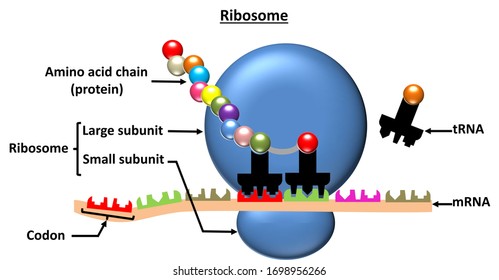RIBOSOMES:-
Ribosomes are small, tiny, spheroidal dense particles present in all living cells. The word ribosome is derived - 'ribo' from ribonucleic and 'somes' from the Greek word "soma" means 'body'. They are the sites of protein synthesis. These ribosomes are primarily found in both prokaryotic and eukaryotic cells. Ribosomes link amino acids together in the order that is specified by the messenger RNA (mRNA) and is of 150-200 Angstroms. A ribosome is made from complexes of RNAs and proteins, and is, therefore a ribonucleoprotein. Around 37-62% of ribosomes are made up of RNA and the rest is proteins.
Structure of Ribosomes:

The ribosomes are small particles present in large numbers in many cells. Each ribosome consists of two subunits:- a) larger subunit and
b)smaller subunit
a) The larger subunit bind to tRNA, amino acids, and the smaller subunit.
b)The smaller subunit binds to a larger subunit and mRNA pattern.
Ribosomes are located in two regions of the cytoplasm. Some are found scattered in the cytoplasm and some are attached to the Endoplasmic reticulum. When the ribosomes are bound to ER, they are known as Rough endoplasmic reticulum. The bound and free ribosomes are similar in structure and are involved in protein synthesis.
Note:- The subunits of ribosomes are named according to their ability of sedimentation on a special gel called as "Svedberg" and hence svedberg units.
- The prokaryotes have 70s ribosomes where each subunit consists of a small unit of 30s and a large subunit of 50s.
- The eukaryotes have 80s ribosomes where each subunit consists of small unit of 40s and a large subunit of 60s.
- The ribosomes found in the chloroplasts or mitochondria of eukaryotes that consist of large and small units bound together with proteins into one 70s particle.
- The number of ribosomes in a cell depends on the activity of the cell.
- The ribosomes share a core structure and the two subunits fit together and work as one to translate the mRNA into a polypeptide chain during protein synthesis.
- During protein synthesis, when multiple ribosomes are attached to the same mRNA strand, this structure is called as "polysome".
- The location of the ribosomes in the cell determines what type of protein it makes.For eg; if the ribosomes are freely situated throughout the cell, it will make proteins that will be utilized within the cell itself.
Functions:-
The functions of the ribosomes can be explained in the following different ways:-
- The ribosomes are the major sites of protein synthesis.
- These ribosomes assemble amino acids to form specific proteins that are essential to carry out cellular activities.
- The genetic message from the mRNA is translated into the proteins during DNA translation.
- The ribosomes are also involved in DNA transcription, a process in which the proteins are produced; where deoxyribonucleic acid produces mRNA that is later converted into proteins.
- The mRNA is synthesized in the nucleus and is transported to the cytoplasm for further protein synthesis.
- The two subunits of ribosomes are bound around the polymers of mRNA in the cytoplasm; and proteins are then synthesized with the help of transfer RNA (tRNA).
 |
| protein synthesis diagrams |
- courtesy by google images

site of ribosome biogenesis?
ReplyDeletethank you for reading visit again for more info on biosciences
Deletewhere do ribosomes synthesize?
ReplyDeleteIn bacterial cells, ribosomes are synthesized in the cytoplasm through the transcription of multiple ribosome gene operons. In eukaryotes, the process takes place both in the cell cytoplasm and in the nucleolus, which is a region within the cell nucleus.
Delete